
Oct 18, 2024
How To Avoid Inactive YouTube Subscribers
Aleksander
Have you ever wondered why this happens to some channels? Why they have hundreds of thousands and maybe even millions of subscribers, and yet they can barely break a couple thousand views? In this blog post, we cover…
The different type of viewers on YouTube
How the YouTube recommendation algorithm operates and why consistent channel offering is important
Why some channels rake up hundreds of thousands of inactive subscribers
How to use trends with a consistent channel offering
The different type of viewers on YouTube
To explain why channels rake up hundreds of thousands of inactive subscribers, we first have to identify the different type of viewers on YouTube.
Every viewer is different.
In the analytics page, they all look the same, but in reality, they are very different from one another. While a viewer could be categorized into many different categories, we are going to divide them into four categories to make it simple.

The first viewer category is “first-timers”, which are viewers that watch your content for the first time. “First-timers” can be converted into three different viewers: “inactives”, “regulars” and “die-hards”.

Die-hards are your most loyal superfans. They go beyond just watching everything; they actively engage with your videos and might even buy your merchandise and other products. The goal with every first-timer is to eventually turn them into a die-hard superfan. This is because die-hard superfans actively engage with your videos, buy merchandise and products you might offer. They are essentially the most valuable viewer you can get.
The other positive viewer is the regulars, which watch your videos on a regular basis. They are not as valuable as die-hards, but are still very beneficial viewers.
On the other side, we have the type of viewer every channel aims to avoid, which are inactives. Inactives have watched your content once, might have subscribed, but doesn’t watch your content anymore. They are a lost viewer. Inactives have a negative impact on a channel.
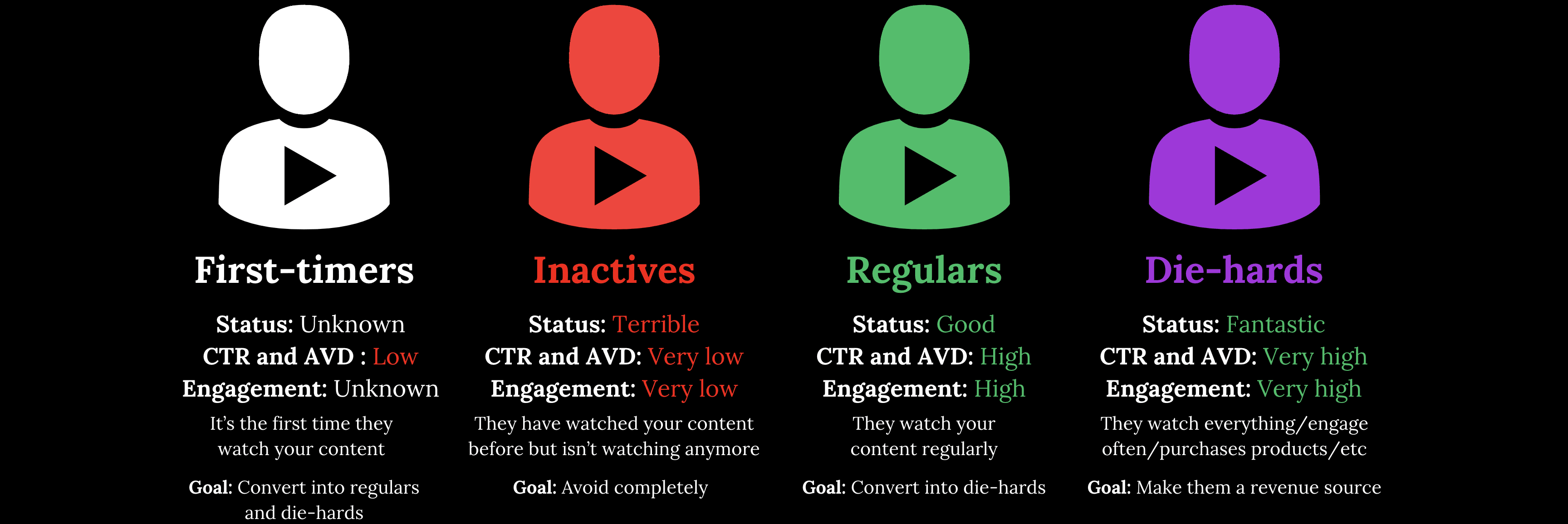
To explain why inactives is such a disaster, let’s first explain how the YouTube recommendation algorithm works and the important implications of having a consistent channel offering (consistency of the type of videos you offer across your channel).
How the YouTube recommendation algorithm operates and why consistent channel offering is important
When you watch a video, you get recommended different YouTube videos based on what you are watching.
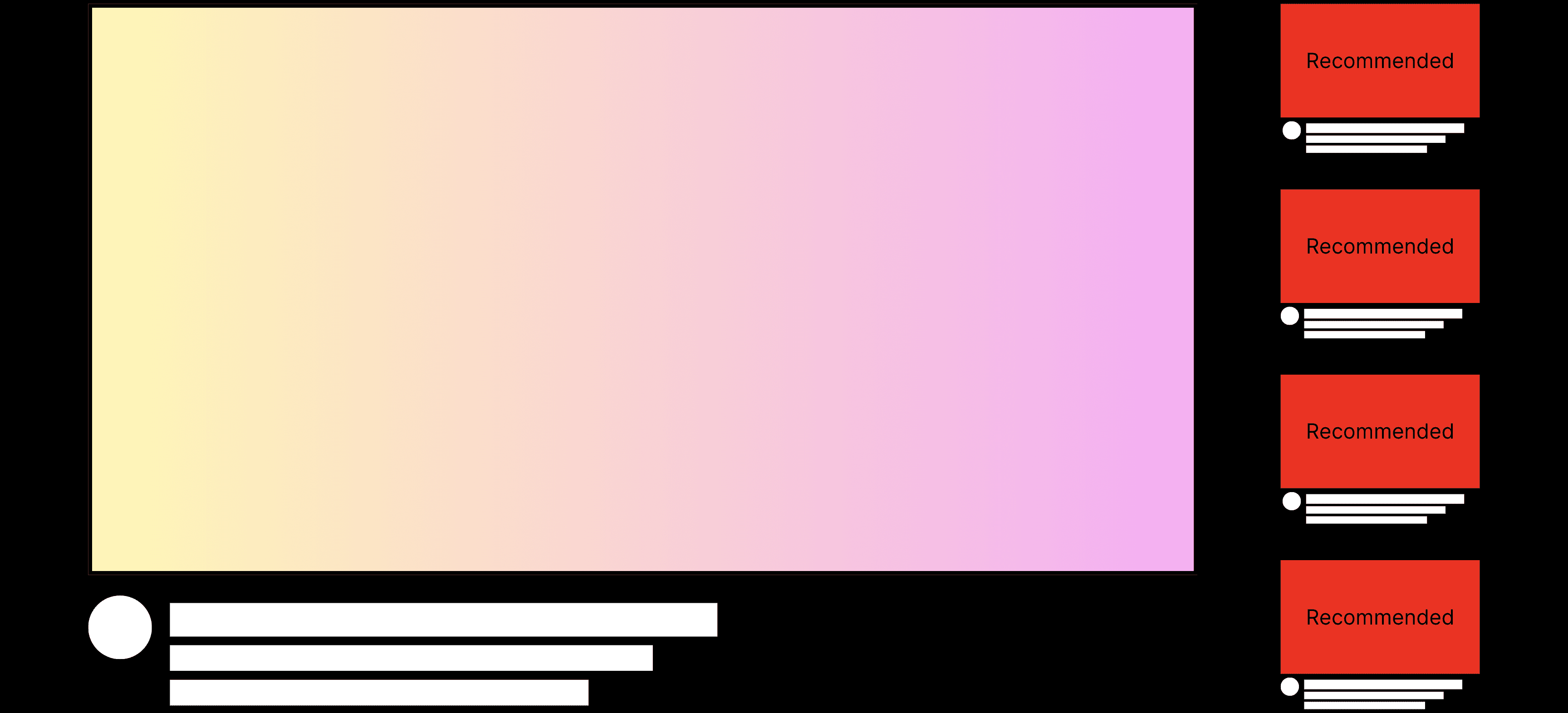
The goal of the YouTube algorithm is to predict what content you are likely to watch next based on what you watched previously. This results in it often recommending other videos from the channel they are watching.
How the YouTube algorithm categorizes videos are dependent on different variables such as topic, title, thumbnail, video duration, video style, content and more. These variables can simply be termed the video’s offering, and it helps the YouTube algorithm categorize videos.

Getting your video recommended and watched works very well when the content is similar, like depicted below. After all, when we have gotten hooked on something we want more, and we want it now. We also have a large tendency to fall into habits.

It’s the same fantasy universe, using the same video style, with the same presentation, with the same length, with same genre, etc. The only variable here differentiating the two videos are the battle itself.
But what if the content viewers get recommended doesn’t have a similar video offering? The two videos below might feel very similar as they are both covering the same fantasy universe, however, the videos are in fact very different.
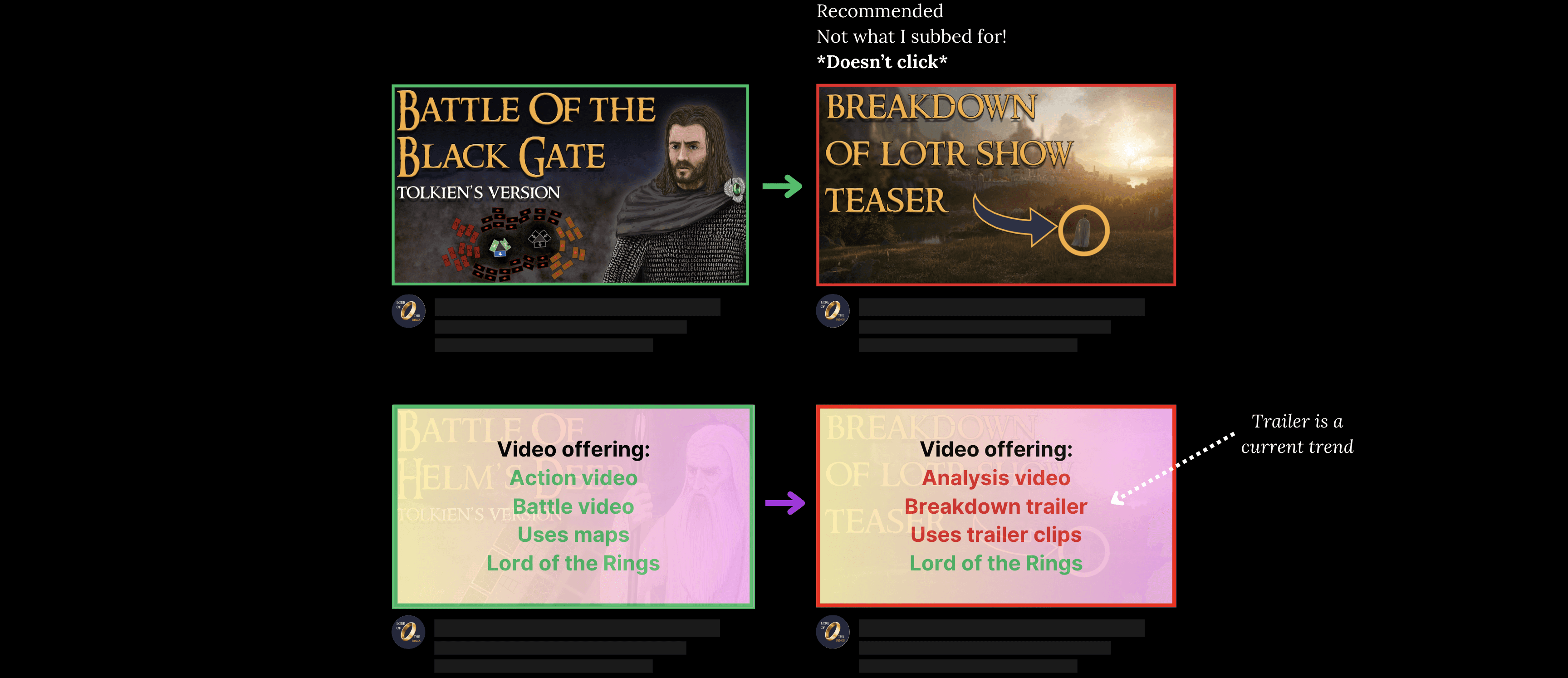
One of the videos covers a battle using maps and is very action-based, while the other is an analysis video which breaks down a trailer and they use completely different presentation technique. Furthermore, the trailer breakdown is based on a short-term trend, while the battle video is a video that will have demand for as long as the fantasy universe is popular. One targets views for the short-term (trailer), the other views for the long-term (battle).
Some viewers will watch both videos, but most won’t because of the mismatch.
Now take a minute and take a look at this viewer behavior to see the implications of similar and different video offerings.

As you can see here, the first three videos looks very similar. Indeed, their video offering is basically identical. When first-timers watch the first video, they are likely to get hooked and end up watching the next two as well. However, the fourth video breaks that chain and the same for the fifth video.
The YouTube algorithm instead directs them to a new channel that has a similar video offering to the first three videos. That video better matches the video offering they initially watched for/subscribed for.
When you don’t have a consistent channel offering, you will end up routing the traffic from your videos to other channels that better matches what they are looking for. In other words, the binge-watching on your channel stops… Exactly the opposite of what we want!
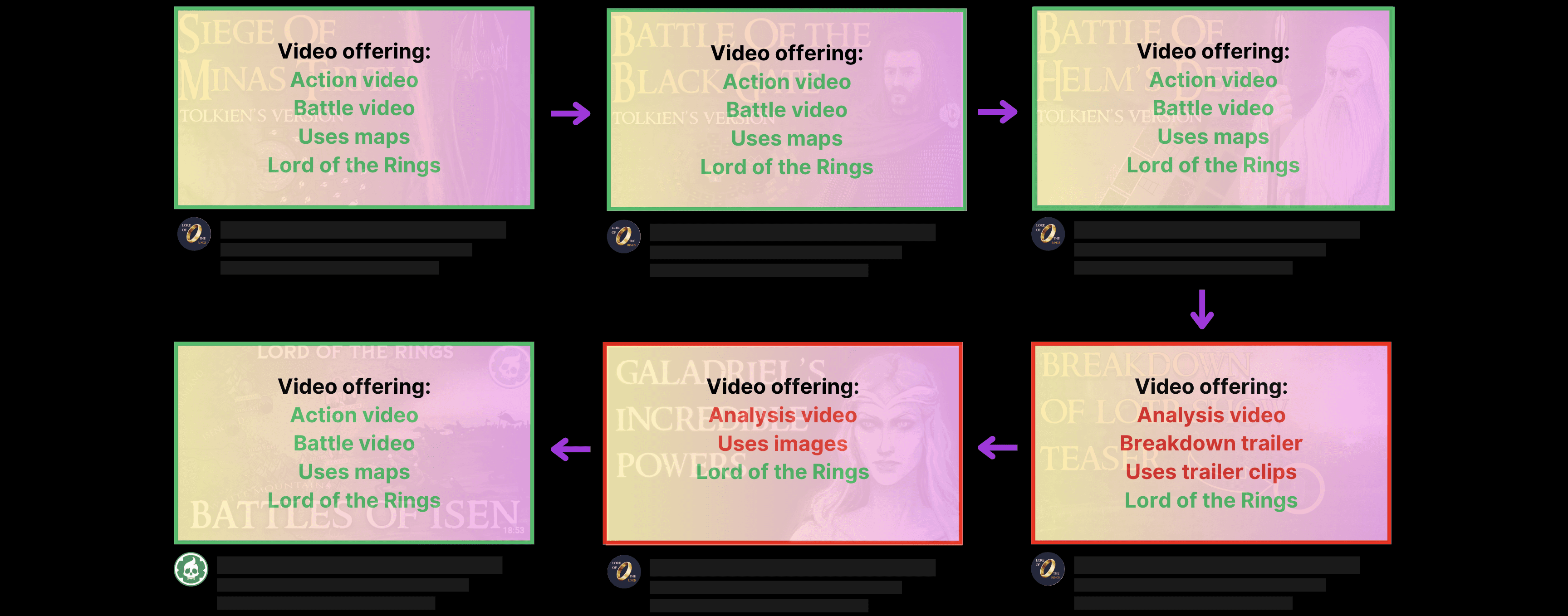
Remember, that the YouTube recommendation algorithm constantly tries to find identical video offerings to increase the likelihood of you watching another video on the platform. When you halt their binge-watching, you are hurting your potential success. And it’s not only bad, it can be absolutely disastrous. Let’s look at how one accumulates inactives.
Why some channels rake up hundreds of thousands of inactive subscribers
Inconsistent channel offerings doesn’t only incentivize the algorithm to look away from your videos, but it can also result in your viewers becoming inactives.

The more inconsistent your channel offering over time, the more inactives accumulate. And this compounds over time. The problem now, is that some subscribed for one type of video offering, while some others subscribed for another type. Even when uploading new videos, you will not get as many clicks, because your subscribers initially subscribed for different video offerings.
Inconsistent channel offering is one of the primary reasons (but not always the reason) you sometimes see channels with almost 1 million subscribers but with only a couple hundred views per video. For years, they have had an inconsistent channel offering and their videos only appeals to a few by this point.
Not all channels can have a consistent channel offering because their content in nature is very varied. For these channels, the goal must be to make it as consistent as possible. Or they can pivot and try to choose a more consistent channel.
It must be emphasized that inactives can happen for other reasons as well, but by delivering a consistent video offering, you reduce the chance of converting first-timers to inactives.
This is the point to take home and practice.
But one key question remains, which is how to you use trends without ruining your consistent channel offering.
How to use trends without gaining inactives
Trends can provide a lot of views, but they can also attract first-timers that get converted to inactives. As a result, you ought to be careful when you use trends in your content. Don’t be tempted by a short-term win for a long-term loss.

The right way to use trends is to make sure they are consistent with your video offering. This means you can’t deviate much from your usual video offering. I made the mistake of having too large of an deviation here, and paid the price (in terms of few views and the development of inactives in my audience).

I did use a trend, but applied it poorly. Most times, it’s better to abstain from using the trend altogether, than risk compromising your channel offering.
Let’s make an example of a trend that could have been compatible with my channel offering. Recently, a TV Series was launched for the same fantasy universe I create videos for. It recently depicted “The Battle of Eregion”. In that case, this video could have been created:

The thumbnail here isn’t perfect, but the point is that this is a far more compatible trend for this channel. Let’s look at another example. Recently I found a trend using Viral Dashboard, and it is related to “recreating”. Essentially it takes something and recreates it.

Using the “recreating” trend, I could have produced this “recreated version” of the original version (Tolkien’s version). The thumbnail isnt perfect here either, but it illustrates the point.
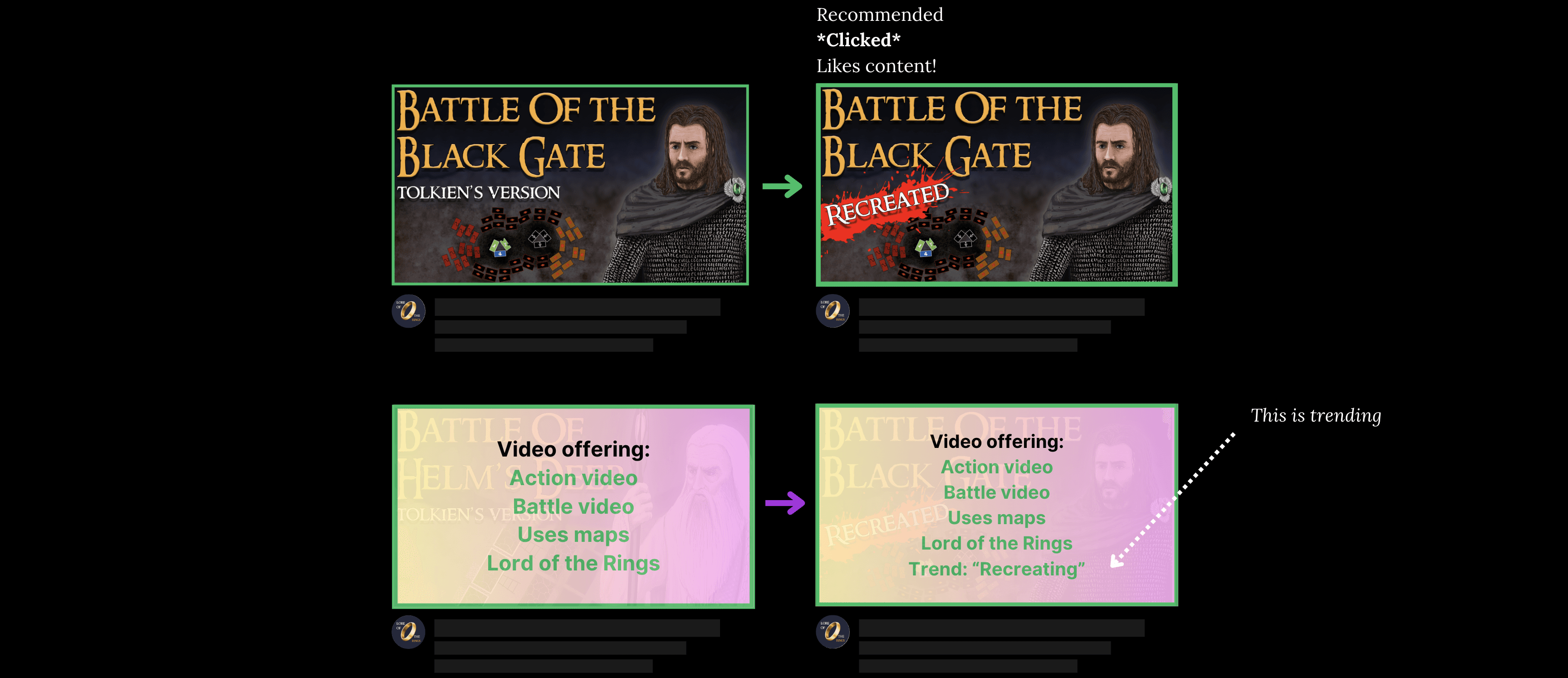
Using trends can be powerful, just don’t stretch it too far from your video offering. Certain trends are more risky than others because they attract a very different audience. Always have this in mind!
If you want to identify trends, you can use Viral Dashboard which gives you a complete overview of hot video trends on YouTube; it’s a collection of thousands of video topics that contains proven demand, momentum and narratives. What benefits can you expect from Viral Dashboard?
Remove boring and tiring tasks. Get instant access to trends
Save time. Reduce the research time for finding outliers by more than 90%
Get more views. Improve your video success rate and lower the risk of flops
As a thanks for reading this entire blog post, I am giving you a special coupon code: EARLYBIRD2024. That gives you 30% off for a year’s subscription of Viral Dashboard (that’s not even $6 month).
Subscribe today, and increase your chance of creating viral videos!
